User personas are an essential part of the UX designer’s toolkit. Get started with these free, fully customizable user persona templates.
Whether you’re a seasoned UX designer or just starting out, user persona templates are incredibly useful. They provide a structured framework to help you create fictional representations of your target users, exploring your users’ goals, preferences, behaviors, and pain points.
With all the building blocks in place, you don’t need to worry about designing a persona from scratch. You can focus on what matters most: gathering real user data and accurately representing your target audience.
And, as luck would have it, there are some truly awesome—and free—user persona templates out there, just ready and waiting to be completed and customized. Let’s explore the best of the best!
Contents:
- What is a user persona?
- How do you design a user persona?
- What should a user persona template include?
- 7 awesome free user persona templates for UX designers
- Additional tools and resources for UX designers
If you want to skip straight to the persona templates, just use the clickable menu.
What is a user persona?
A user persona is a fictional character that represents your target users, typically presented as a one or two-page summary with text and images.
Based on data gathered through user research, personas capture key information about different segments of your audience. This guides you throughout the UX design process, helping you to design with your end users’ needs, goals, preferences, and pain points in mind.
User personas are an extremely valuable tool, whether you’re creating a new product from scratch or improving an existing one. When you create user personas, you turn your research data into relatable characters. This helps to cultivate empathy, foster a common understanding of your target users within your organization, and, most importantly, make sure you prioritize the user when making decisions about the product.

How do you design a user persona?
If you want to create a user persona, there are three key steps you’ll need to follow.
- Conduct user research. This provides you with the data that will shape your user personas. Depending on your goals and where you’re at in the design process, you might conduct user interviews, surveys, diary studies, or focus groups to learn more about who your target users are and what they require from your product.
- Analyze your findings and segment your audience based on commonalities and themes within your data. For example, you might identify one user group that is motivated by convenience, another who values cost savings, and yet another intent on reducing their carbon footprint. Each audience segment will be represented by its own user persona.
- Create your personas. Using a template, fill out the relevant details that will complete your persona, adding a name, demographic details, images, and a description of the persona’s goals, motivations, preferences, and pain points in relation to the product you’re designing.
Once your personas are complete, you’ll share them with key stakeholders for feedback and iterate accordingly. An excellent example of user personas and their impact on the design process can be observed in this UX Research Project by AND learners.
For a more detailed step-by-step guide, refer to this post: What Is a User Persona and How Do You Create One?
What should a user persona template include?
You’re here to find the best user persona templates—so what should you be looking for when choosing a template?
A good user persona template generally includes designated fields for the following:
- Your persona’s name and headline
- A demographic profile (e.g. age, occupation, location, budget available to spend on the product, gender, relationship status, etc.)
- Goals and objectives—what the persona hopes to achieve when using your product
- Motivations—what drives them to achieve their goals and encourages them to engage with a product?
- Challenges and pain points—what issues do they currently face within the context in question? What problems do they need you to solve?
- Behaviors and preferences
- Images
- Quotes
Your user persona template should be visually appealing, comprising a good balance of text and imagery, and it should present all key information in a concise and skimmable format; you want to make sure your persona is easy to read and digest.
At the same time, look for a user persona template that’s customizable and collaborative. Ideally, you’ll have plenty of flexibility to adapt the template to suit your needs and share it with others.
Ultimately, you want your personas to be memorable, meaningful, and relatable—and the right template will help you to achieve that. So, without further ado, let’s explore some of the best user persona templates out there.
7 awesome free user persona templates for UX designers
i. Free user persona template for Miro by Megan Cattley
- Price: Free
- Why use this persona template? It’s clear, easy to use, customizable, and action-based.
- Link: You can access this free template for Miro here.
Miro is a much-loved UX design tool, not least for its extensive library of customizable templates. This free user persona template is simple, collaborative, and incredibly easy to use. All you need is a Miro account (also free).
The template opens up in a new Miro board which you can edit and customise directly. You’ll find step-by-step instructions explaining how to use the template and fill in the relevant details, together with an example of how you might complete each field.
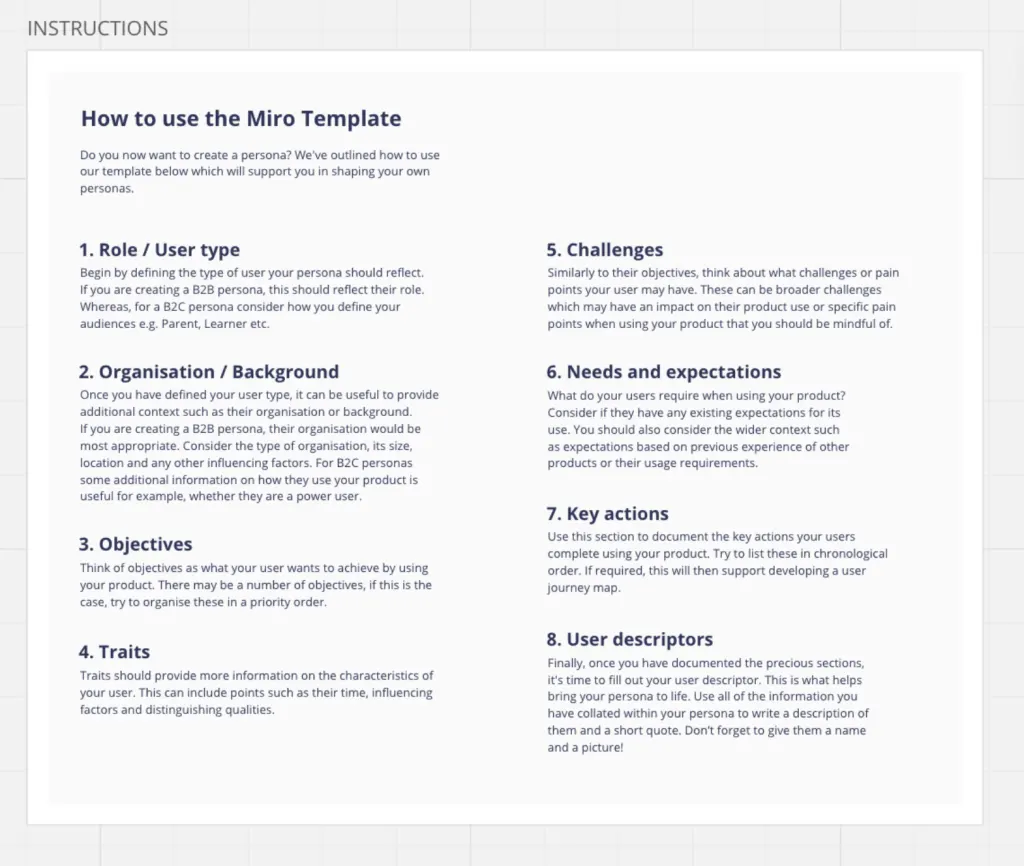
This free user persona template includes everything you need to represent your target audience, including space for:
- An image
- A persona name
- A quote
- A description
- Role/user type
- Organization/background
- Objectives
- Traits
- Key actions the user takes before, during, and after engaging with your product
- Challenges
- Needs
- Expectations
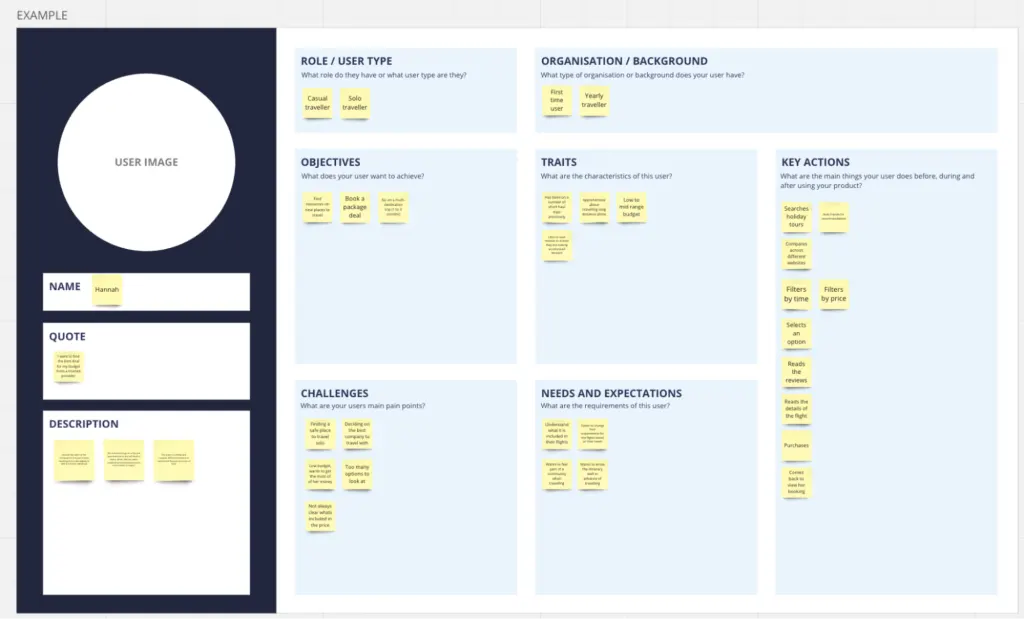
We love this user persona template because it’s action-based. It encourages you to think about your user’s behaviours in relation to your product, which is incredibly useful when it comes to defining core features and functionality.
ii. Xtensio free user persona template
- Price: Free
- Why use this persona template? It’s collaborative, highly customizable, and user-friendly thanks to the drag-and-drop interface.
- Link: You can access this free user persona template here.

Xtensio is a business communications platform that enables collaborative content creation. And, while it’s not a UX design tool per se, it does offer an excellent free user persona template.
In its original format, the template contains the following sections for your user persona:
- Name and image
- Demographic profile
- Personality
- Goals
- Frustrations
- Bio
- Motivation
- Brands and influencers
- Preferred channels
However, you’re not restricted to this format. Xtensio’s free user persona template is highly customizable; you can drag and drop to rearrange elements, add new content blocks such as images, videos, charts, and graphs to make your persona more engaging and customize the template’s color and background.
Another great benefit of this particular template: it’s built for collaboration and sharing. You can add multiple collaborators to the project and, once you’re happy with your persona, share it via a link, download it, or embed it into a presentation.
iii. Free user persona template for Figma by Cheniece Manning
- Price: Free
- Why use this persona template? It’s concise, looks great, and it’s easily accessible in Figma.
- Link: Try this free Figma user persona template here.
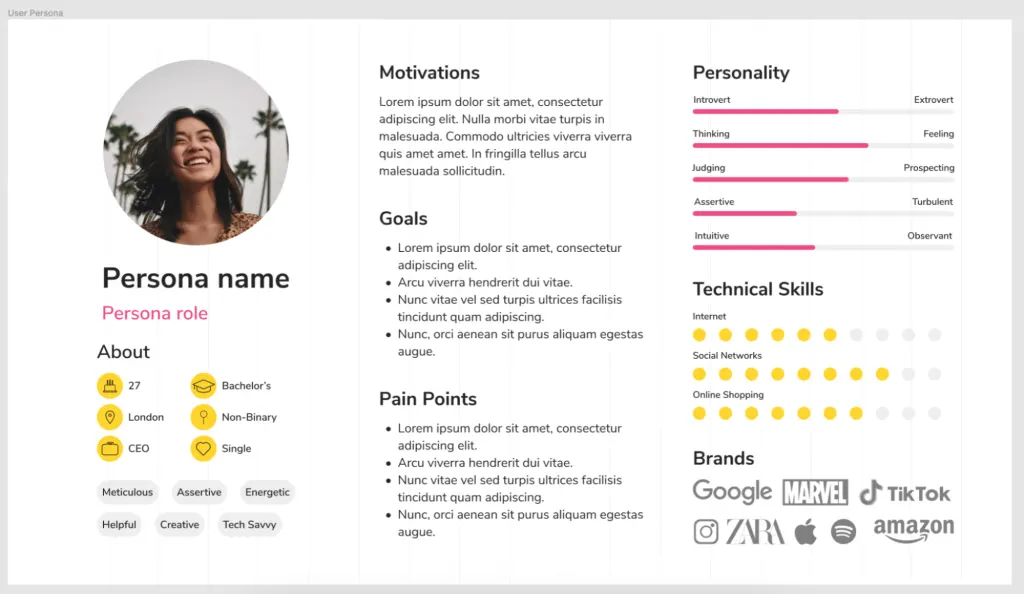
If you’re an avid Figma user, you’ll love this free template created by Cheniece Manning. Arranged into three neat columns with plenty of white space, this is one of the most well-presented persona templates we’ve come across.
The template features all the crucial information you need to build an effective persona, including:
- Persona image, name, and role
- An ‘about’ section featuring demographic details
- Tags for relevant traits and characteristics
- Motivations
- Goals
- Pain-points
- Personality type (with adjustable scales)
- Technical skills
- Brands of interest
What’s particularly great about this template is that it explores the user’s personality traits and skills on a spectrum, allowing for a more nuanced representation of your target users.
Accessible in Figma, the template is inherently easy to use. Just double-click on specific elements to edit the content, and use the drag-and-drop interface to rearrange content blocks. You’ll have a fully-fledged user persona in no time!
iv. User persona planning whiteboard (free with Canva)
- Price: Free
- Why use this persona template? It’s a simple, easy tool that will help kick-start the persona creation process.
- Link: Try Canva’s free user persona planning whiteboard here.

This isn’t just a user persona template that you fill in with existing data; it’s more like a planning tool that takes you through the process of building out your personas and bringing them to life.
Within the planning board, you’ll find step-by-step instructions explaining how the tool works (it’s delightfully simple—you just drag and drop sticky notes into the relevant boxes). And you don’t need to work alone; you can invite your colleagues to collaborate with a quick click of the ‘plus’ button in the top right-hand corner.
And, of course, the template covers all the essentials:
- Persona name, image, and demographic profile
- Goals
- Quotes
- Description
- Personality
- Brands and apps they use
- Motivators
- Influences
- Frustrations
- Interests
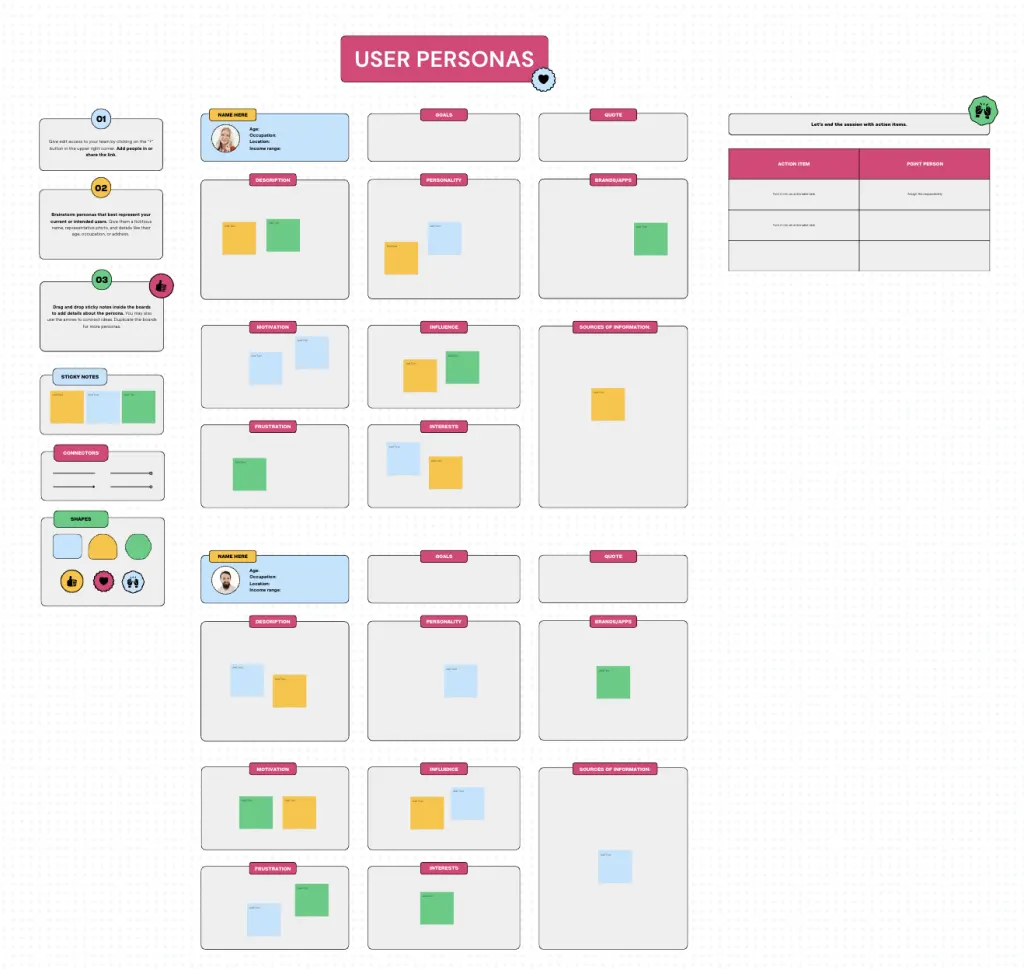
The persona planning whiteboard also includes a table for action items. Once you’ve fleshed out your persona, you can identify action points such as “conduct more user research” or “share personas with stakeholders for feedback.” This ensures that your personas are incorporated into the design process and used to guide product decisions.
v. Minimalistic user persona template by Venngage
- Price: Free
- Why use this persona template? If you want to create a one-page user persona with a minimalistic design, this is the template for you.
- Link: You can access the template here.
This single-page template is a testament to the notion that less truly can be more when it comes to user personas. With its clean design and concise layout, it’s an invaluable tool for capturing your users with clarity and precision.
Despite its brevity, the template covers everything you need to create a well-rounded persona:
- A photo
- An impactful user quote
- A brief demographic summary
- An ‘about’ section
- A bio
- Skills
- Motivation
- Goals
- Personality (conveyed as percentages across different categories)
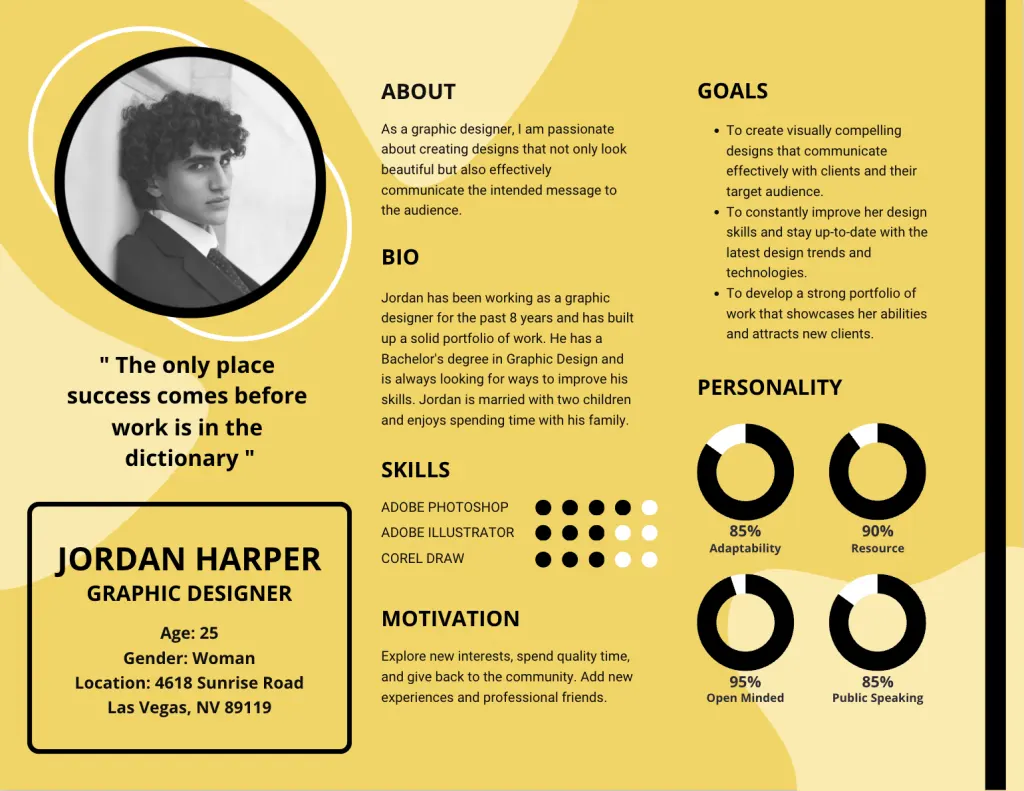
The tool itself is extremely user-friendly, and the template is fully customizable. Double-click on individual content blocks to edit them, and use the toolbar to add new elements such as text, icons, photos, and charts.
Want to align your user personas with your brand’s color palette? No problem. You can use the Brand Kit function to autofill your brand colours, or simply enter your HEX codes.
vi. User persona presentation template (free with Canva)
- Price: Free
- Why use this persona template? Creating your personas is only half the journey. Use this presentation template to share your personas with colleagues, clients, or the wider company.
- Link: You’ll find this free user persona template on Canva.



Creating user personas should be an iterative process. It’s important to test your personas, gather feedback from key stakeholders, and revise them accordingly. This ensures that your personas are accurate, meaningful, and useful for everybody who might need them.
Use this persona presentation template to introduce multiple personas and run a collaborative workshop—either to gather feedback in real time or generate ideas for how your personas can be improved.
Just open the template in Canva and double-click on individual elements to customize them. For each persona, you’ll fill in the following information:
- Name, age, occupation, and location
- Image
- User description
- Personal characteristics
- Hobbies and interests
- Goals
- Challenges
- Needs
Of course, you can add or remove certain elements depending on your needs—the template is fully customisable.
Once your presentation is complete, you can share it, download it, or use the ‘Present and record’ functionality to record yourself presenting.
vii. Lucidchart free user persona template
- Price: Free
- Why use this persona template? It’s digestible, actionable, and allows you to import research data from other platforms.
- Link: Log in to Lucidchart (it’s free to create an account) to access this free user persona template.
Lucidchart is a web-based app used for creating simple charts and diagrams—and, of course, user personas. This free user persona template is simple by design; ideal if you want to create high-level persona outlines before building more in-depth characters.
The template has designated fields for:
- A persona image
- Name, age, occupation, and archetype
- Technology expertise level
- Devices used
- Favorite brands or apps
- Goals
- Frustrations

While this persona template is less detailed than others on our list, it does come with some handy features. You can add comments, assign tasks and action items to team members, record videos, and build a presentation based on your persona template.
Most useful, though, is the ‘import data’ function. You can import data from a Google Sheets or Microsoft Excel file, or from another platform like Salesforce. Handy for creating data-driven user personas that are steeped in real user research!
5. Additional tools and resources for UX designers
That concludes our free user persona template round-up. We hope you found one to suit your needs!
If you’re looking for additional tools and resources to help you throughout the design process, continue with these guides:
- Create buyer personas using pre-structured templates from HubSpot
- 17 Fundamental UX Design Principles and How To Apply Them
- A Glossary of 50+ UX/UI Terms Every Designer Should Know
- 8 Great Examples of UX Design to Inspire Your Next Project
Looking for a formal education in UX? Consider a professional UX design course. With AND Academy, you’ll cover all the essential principles, tools, and processes that UX designers use in their day-to-day work—from user research and persona creation to wireframing and prototyping, right through to usability testing. You’ll attend live, interactive sessions with expert instructors and complete real-world projects to add to your portfolio. Learn more about AND Academy’s design courses here.
4. What’s Next?
We trust this compilation of the best user persona templates has proven beneficial to you. For further information on UX design, here is a selection of additional resources that you can consider:
- Watch this session by Shiva Viswanathan, Design Head of Ogilvy Pennywise, and Naman Singh, Product Experience Designer at RED.
- Talk to a course advisor to discuss how you can transform your career with one of our courses.
- Pursue our UX UI Design courses - all courses are taught through live, interactive classes by industry experts, and some even offer a Job Guarantee.
- Take advantage of the scholarship and funding options that come with our courses to overcome any financial hurdle on the path of your career transformation.
Note: All information and/or data from external sources is believed to be accurate as of the date of publication.










